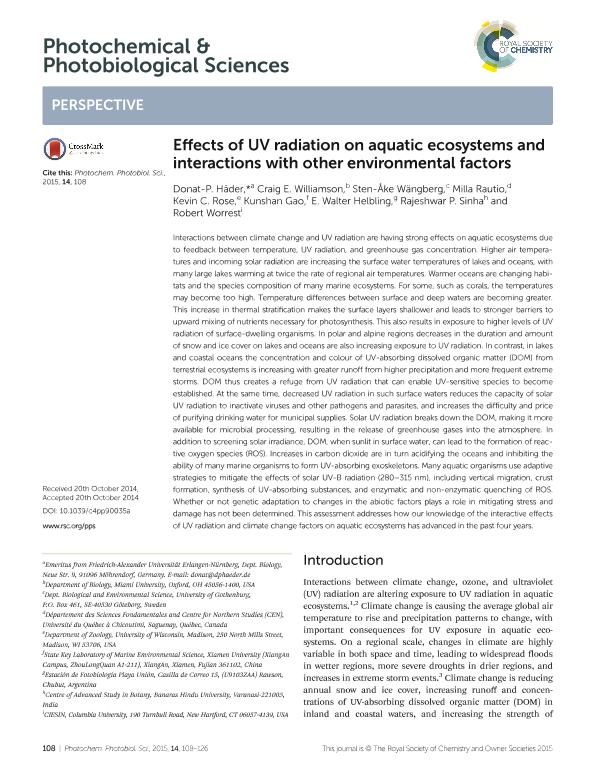Mostrar el registro sencillo del ítem
dc.contributor.author
Häder, Donat P.
dc.contributor.author
Williamson, Craig E.
dc.contributor.author
Wängberg, Sten Åke
dc.contributor.author
Rautio, Milla
dc.contributor.author
Rose, Kevin C.
dc.contributor.author
Gao, Kunshan
dc.contributor.author
Helbling, Eduardo Walter

dc.contributor.author
Sinha, Rajeshwar P.
dc.contributor.author
Worrest, Robert
dc.date.available
2016-05-12T18:36:22Z
dc.date.issued
2015-01
dc.identifier.citation
Häder, Donat P.; Williamson, Craig E.; Wängberg, Sten Åke; Rautio, Milla; Rose, Kevin C.; et al.; Effects of UV radiation on aquatic ecosystems and interactions with other environmental factors; Royal Society of Chemistry; Photochemical and Photobiological Sciences; 14; 1; 1-2015; 108-126
dc.identifier.issn
1474-905X
dc.identifier.uri
http://hdl.handle.net/11336/5634
dc.description.abstract
Interactions between climate change and UV radiation are having strong effects on aquatic ecosystems due to feedback between temperature, UV radiation, and greenhouse gas concentration. Higher air temperatures and incoming solar radiation are increasing the surface water temperatures of lakes and oceans, with many large lakes warming at twice the rate of regional air temperatures. Warmer oceans are changing habitats and the species composition of many marine ecosystems. For some, such as corals, the temperatures may become too high. Temperature differences between surface and deep waters are becoming greater. This increase in thermal stratification makes the surface layers shallower and leads to stronger barriers to upward mixing of nutrients necessary for photosynthesis. This also results in exposure to higher levels of UV radiation of surface-dwelling organisms. In polar and alpine regions decreases in the duration and amount of snow and ice cover on lakes and oceans are also increasing exposure to UV radiation. In contrast, in lakes and coastal oceans the concentration and colour of UV-absorbing dissolved organic matter (DOM) from terrestrial ecosystems is increasing with greater runoff from higher precipitation and more frequent extreme storms. DOM thus creates a refuge from UV radiation that can enable UV-sensitive species to become established. At the same time, decreased UV radiation in such surface waters reduces the capacity of solar UV radiation to inactivate viruses and other pathogens and parasites, and increases the difficulty and price of purifying drinking water for municipal supplies. Solar UV radiation breaks down the DOM, making it more available for microbial processing, resulting in the release of greenhouse gases into the atmosphere. In addition to screening solar irradiance, DOM, when sunlit in surface water, can lead to the formation of reactive oxygen species (ROS). Increases in carbon dioxide are in turn acidifying the oceans and inhibiting the ability of many marine organisms to form UV-absorbing exoskeletons. Many aquatic organisms use adaptive strategies to mitigate the effects of solar UV-B radiation (280–315 nm), including vertical migration, crust formation, synthesis of UV-absorbing substances, and enzymatic and non-enzymatic quenching of ROS. Whether or not genetic adaptation to changes in the abiotic factors plays a role in mitigating stress and damage has not been determined. This assessment addresses how our knowledge of the interactive effects of UV radiation and climate change factors on aquatic ecosystems has advanced in the past four years.
dc.format
application/pdf
dc.language.iso
eng
dc.publisher
Royal Society of Chemistry

dc.rights
info:eu-repo/semantics/openAccess
dc.rights.uri
https://creativecommons.org/licenses/by/2.5/ar/
dc.subject
Uvr
dc.subject
Aqutic Ecosystems
dc.subject.classification
Biología Marina, Limnología

dc.subject.classification
Ciencias Biológicas

dc.subject.classification
CIENCIAS NATURALES Y EXACTAS

dc.title
Effects of UV radiation on aquatic ecosystems and interactions with other environmental factors
dc.type
info:eu-repo/semantics/article
dc.type
info:ar-repo/semantics/artículo
dc.type
info:eu-repo/semantics/publishedVersion
dc.date.updated
2016-04-28T14:51:39Z
dc.journal.volume
14
dc.journal.number
1
dc.journal.pagination
108-126
dc.journal.pais
Reino Unido

dc.journal.ciudad
Cambridge
dc.description.fil
Fil: Häder, Donat P.. Universitat Erlangen-Nuremberg; Alemania
dc.description.fil
Fil: Williamson, Craig E.. Miami University; Estados Unidos
dc.description.fil
Fil: Wängberg, Sten Åke. University of Gothenburg. Department of Biological and Environmental Science; Suecia
dc.description.fil
Fil: Rautio, Milla. Université du Québec à Chicoutimi. Département des Sciences Fondamentales and Centre for Northern Studies; Canadá
dc.description.fil
Fil: Rose, Kevin C.. University Of Wisconsin; Estados Unidos
dc.description.fil
Fil: Gao, Kunshan. Xiamen University. State Key Laboratory of Marine Environmental Science; China
dc.description.fil
Fil: Helbling, Eduardo Walter. Fundación Playa Unión. Estación de Fotobiología Playa Unión; Argentina. Consejo Nacional de Investigaciones Científicas y Técnicas. Centro Nacional Patagónico; Argentina
dc.description.fil
Fil: Sinha, Rajeshwar P.. Banaras Hindu University. Centre of Advanced Study in Botany; India
dc.description.fil
Fil: Worrest, Robert. Columbia University; Estados Unidos
dc.journal.title
Photochemical and Photobiological Sciences

dc.relation.alternativeid
info:eu-repo/semantics/altIdentifier/url/http://pubs.rsc.org/en/Content/ArticleLanding/2015/PP/C4PP90035A#!divAbstract
dc.relation.alternativeid
info:eu-repo/semantics/altIdentifier/doi/http://dx.doi.org/10.1039/C4PP90035A
dc.relation.alternativeid
info:eu-repo/semantics/altIdentifier/doi/10.1039/C4PP90035A
Archivos asociados
